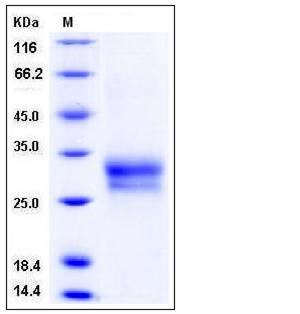Human CTHRC1 Protein (His Tag)
CTHRC1
- 100ug (NPP3783) Please inquiry
| Catalog Number | P11647-H08H |
|---|---|
| Organism Species | Human |
| Host | Human Cells |
| Synonyms | CTHRC1 |
| Molecular Weight | The recombinant human CTHRC1 consists of 224 amino acids and has a predicted molecular mass of 24.5 kDa. In SDS-PAGE under reducing conditions, the apparent molecular mass of rh CTHRC1 is approximately 28-33 kDa due to glycosylation. |
| predicted N | Ser 31 |
| SDS-PAGE |  |
| Purity | > 95 % as determined by SDS-PAGE |
| Protein Construction | A DNA sequence encoding the human CTHRC1 (NP_612464.1) (Met 1-Lys 243) was fused with a polyhistidine tag at the C-terminus. |
| Bio-activity | |
| Research Area | Cancer |Invasion microenvironment |Angiogenesis |Adhesion Molecules in Angiogenesis |Extracellular Matrix |ECM Proteins | |
| Formulation | Lyophilized from sterile PBS, pH 7.4 1. Normally 5 % - 8 % trehalose, mannitol and 0.01% Tween80 are added as protectants before lyophilization. Specific concentrations are included in the hardcopy of COA. |
| Background | Collagen triple helix repeat-containing protein 1, also known as Protein NMTC1, and CTHRC1, is a secreted protein that is glycosylated and highly conserved from lower chordates to mammals. CTHRC1 expression was not detectable in normal arteries. However, it is transiently expressed in the arterial wall in response to injury where it may contribute to vascular remodeling by limiting collagen matrix deposition and promoting cell migration. A short collagen motif with 12 Gly-X-Y repeats appears to be responsible for trimerization of the CTHRC1 protein and this renders the molecule susceptible to cleavage by collagenase. CTHRC1 overexpression caused a dramatic reduction in collagen type I mRNA and protein levels. Currently available data indicate that Cthrc1 expression in vascular cells regulates transforming growth factor beta responsiveness, thereby impacting transforming growth factor beta target genes, including collagens. Additionally, CTHRC1 increases bone mass as a positive regulator of osteoblastic bone formation and offers an anabolic approach for the treatment of osteoporosis. |
| Reference |
